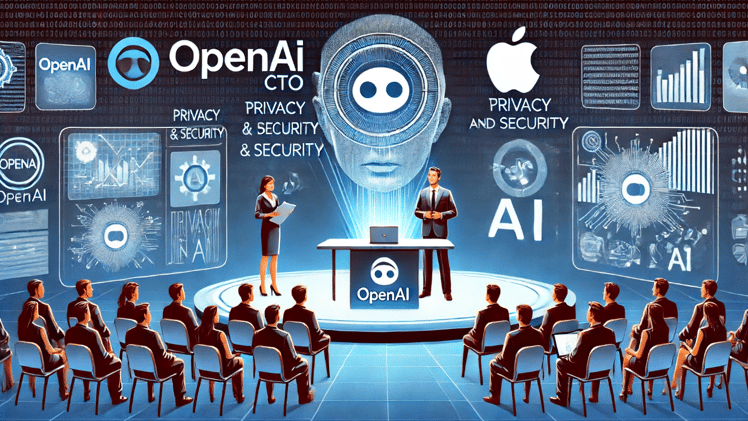Background and Evolution in AI Research
In a recent discussion, Mira Murati, Chief Technology Officer (CTO) at OpenAI, addressed Elon Musk’s criticism of the company’s partnership with Apple. Murati emphasized their commitment to user privacy and safety, providing a detailed overview of their role and the evolution of AI research and applications over the years.
As an individual with a strong academic background in math and physics, Murati’s journey into AI research began through self-driving cars, computer vision, and virtual reality applications. This diverse experience fueled their passion for general artificial intelligence, ultimately leading to their current role at OpenAI. Murati highlighted the importance of integrating research and application across various domains to advance AI technology.
Recent Executive Hires
The conversation also touched on the recent hiring of a new Chief Product Officer and Chief Financial Officer. Murati stressed the need for skilled executives to support OpenAI’s rapid growth, serving millions of users and developers. These hires are seen as critical to the company’s next phase, bringing valuable skills and leadership to the team.
Apple Partnership and Privacy
Murati emphasized the alignment of the partnership with Apple with OpenAI’s values of privacy and safety. They discussed making AI technology accessible while ensuring privacy and safety in product development and deployment. Building trust and transparency in AI technology is paramount, and Murati underscored the importance of user control over data in the Apple partnership.
Addressing Privacy Concerns
Further exploration of the Apple partnership centered on privacy concerns and data usage. Murati addressed how the partnership impacts trust around AI products, clarifying data handling through Apple accounts and prioritizing user privacy. This collaboration aims to build trust and transparency, ensuring that user data is managed securely.
Commitment to Safety and Transparency
Murati defended OpenAI’s commitment to privacy and safety in AI development and deployment, citing a strong track record of safely deploying technology. Transparency in decision-making processes and engaging with the public are key strategies for addressing concerns and building trust in AI technology.
The Importance of User Control
User control over data is crucial in ensuring that AI technology is developed and deployed responsibly. The partnership between OpenAI and Apple prioritizes user privacy, making it clear how data is handled through Apple accounts. This transparency builds trust in AI products, allowing users to make informed decisions about their interactions with these technologies.
Future of AI Technology
Looking ahead, Murati shared their vision for transformative advancements in AI across various sectors, including healthcare and education. They emphasized shared responsibility among stakeholders to make AI technology accessible and understandable to the public. The potential opportunities and risks of Advanced AI were also discussed, highlighting the need for preparedness and responsible deployment.
Progress in AI and Public Access
Reflecting on the progress made in AI, particularly the release of GPT-3, Murati stressed the unique opportunity for the public to access advanced AI models for free. They highlighted the importance of preparing individuals and society for AI integration, discussing AI’s potential in personalized tutoring and other domains.
Balancing Opportunities and Risks
Murati underscored the need to balance the opportunities and risks associated with Advanced AI. Trust-building and safety in deploying these technologies are crucial, and parallels were drawn between engineering and AI development. The importance of infrastructure and trust-building in AI deployment for societal benefit was emphasized.
The Role of Infrastructure in AI Deployment
Infrastructure plays a critical role in AI deployment, ensuring that these technologies are developed and deployed responsibly. Trust-building through transparency and user control is essential in balancing the opportunities and risks associated with Advanced AI. By prioritizing safety and accountability, OpenAI aims to make AI technology accessible and beneficial for society as a whole.
Conclusion: Governance and Accountability
The conversation concluded with a focus on safety measures in AI development and OpenAI’s governance structure. Murati discussed the evolution of the company’s administrative and incentive structures to align with its mission, ensuring accountability and transparency. Balancing incentives and accountability is seen as essential for OpenAI’s continued growth and impact.
Governance Structure: Ensuring Accountability
OpenAI’s governance structure ensures that accountability and transparency are prioritized in AI development and deployment. This includes a focus on safety measures, user control over data, and infrastructure development to support responsible AI technology. By balancing incentives and accountability, the company aims to make a positive impact on society while minimizing risks associated with Advanced AI.
In conclusion, Murati’s discussion highlights OpenAI’s commitment to prioritizing user privacy and safety in AI development and deployment. The partnership with Apple is seen as an opportunity to build trust and transparency in AI technology, ensuring that user data is managed securely. As the field of AI continues to evolve, OpenAI remains focused on balancing opportunities and risks associated with Advanced AI, emphasizing the importance of infrastructure, trust-building, and accountability in making AI technology accessible and beneficial for society.

